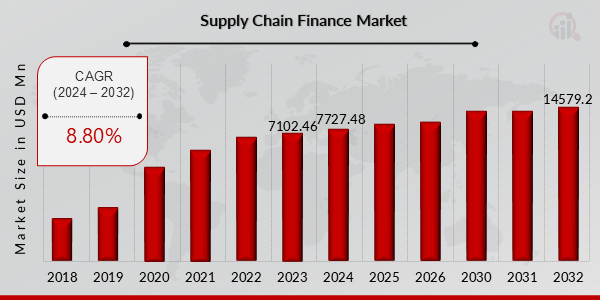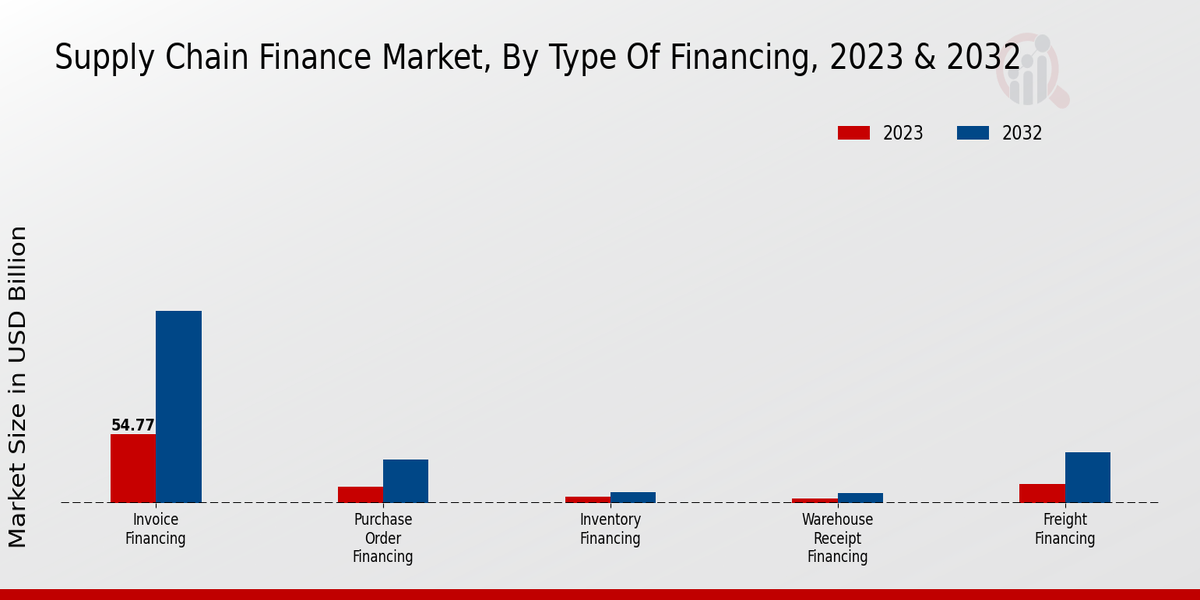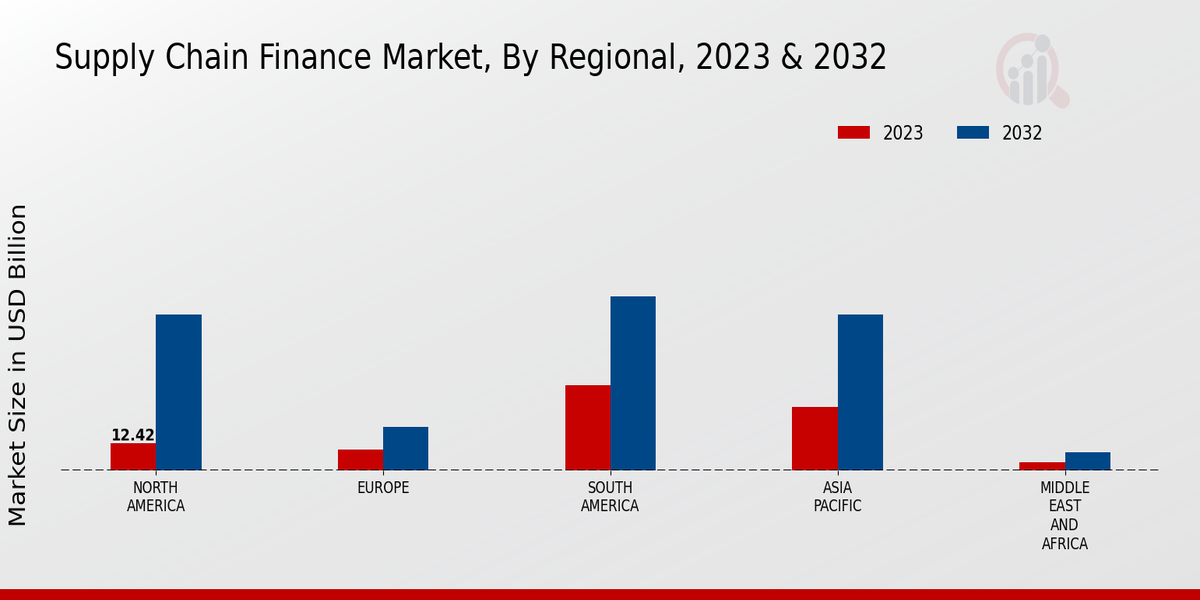Global Supply Chain Finance Market Overview
The Supply Chain Finance Market Size was estimated at 7102.46 (USD Million) in 2023. The Supply Chain Finance Market Industry is expected to grow from 7727.48 (USD Million) in 2024 to 14579.2 (USD Million) by 2032. The Supply Chain Finance Market CAGR (growth rate) is expected to be around 8.80% during the forecast period (2024 - 2032).
Key Supply Chain Finance Market Trends Highlighted
The global supply chain finance market is witnessing a surge in demand due to the growing need for efficient and cost-effective working capital solutions. The proliferation of digital technologies has paved the way for innovative supply chain finance models, such as blockchain-based platforms and data analytics, which offer enhanced visibility, security, and efficiency. Furthermore, the increasing adoption of sustainable practices in supply chains is driving the demand for supply chain finance solutions that align with environmental, social, and governance (ESG) principles. The rapid adoption of e-commerce and the expansion of global supply chains have created opportunities for supply chain finance providers to cater to the specific needs of various industries. The healthcare, manufacturing, and retail sectors are key growth segments, as they require tailored solutions to manage complex supply chains and mitigate risks. Moreover, the emergence of fintech companies and alternative lending platforms is disrupting the traditional supply chain finance landscape, offering innovative and flexible financing options to businesses of all sizes.

Source: Primary Research, Secondary Research, MRFR Database and Analyst Review
Supply Chain Finance Market Drivers
Increasing Need for Working Capital Optimization
Presently, a major driver in the Global Supply Chain Finance Market Industry is the ever-increasing need for businesses to optimize their working capital. Supply chain finance solutions allow businesses to obtain financing secured against their accounts receivable and inventory, enabling the business to improve its cash flow and reduce its dependency on loans from a traditional source. Large businesses that operate extensive and sometimes global supply chains are likely to benefit from the arrangement due to acceptance of extended payment terms, whereas the suppliers may not be as accommodating in extending a similar line of finance. By unlocking previously trapped capital through supply chain finance, businesses are free to reallocate their funds to other areas across the supply chain, thereby increasing efficiency in the process.
Growing Adoption of Digital Technologies
The Global Supply Chain Finance Market Industry also benefits from the rapid adoption of digital technologies. Thanks to the use of digital platforms, supply chain finance has become a transparent and efficient operation. Many businesses have an opportunity to get real-time visibility of what is happening in their supply chain and make well-informed decisions to enhance their presence in the identified niche. The rapid use of digital solutions also benefits the development of new supply chain finance products and services, such as blockchain solutions and AI analytics.
Rising Demand from Emerging Markets
The Global Supply Chain Finance Market Industry is also positively influenced by the increased demand from emerging markets. Businesses in emerging markets are becoming more open to the idea of supply chain finance as a solution to better manage their liquidity and supply chains. With the economic growth and bigger market shares, the increase in demand for supply chain finance solutions is expected to grow further.
Supply Chain Finance Market Segment Insights:
Supply Chain Finance Market Type of Financing Insights
Type of Financing The Global Supply Chain Finance Market is divided by the type of financing into Invoice Financing, Purchase Order Financing, Inventory Financing, Warehouse Receipt Financing, Freight Financing, and Asset-Backed Lending. Invoice Financing is expected to be the largest and the most significant type of financing, with over 40% of the Global Supply Chain Finance Market revenue in 2023. It can be attributed to the ongoing trend of increasing e-invoice adoption and businesses’ perpetual need for working capital. Purchase Order Financing is poised to be the fastest-growing type, with the highest CAGR during the forecast period. It is due to the surge in demand for available early payment discounts and the necessity for suppliers to access finance to fulfill large orders. Inventory Financing is expected to hold a substantial market share in 2023 as businesses aim to optimize the inventory and reduce carrying costs. Warehouse Receipt Financing is also gaining traction as it allows for financing against the inventory stored in warehouses. Freight Financing is expected to grow gradually throughout the period, which is associated with the increased volume of global trade mandating businesses to effectively manage their freight spend. Lastly, Asset-Backed Lending is a type of financing that links assets to the loan, often accounts receivable, inventory, or equipment. It is typical for firms with restricted access to more conventional types of financing. Overall, the market is set to witness substantial growth within the next five years, driven by the increase of digitalization, shortage of working capital, and the deepening complexity of the global supply chains.

Source: Primary Research, Secondary Research, MRFR Database and Analyst Review
Supply Chain Finance Market Industry Vertical Insights
The Global Supply Chain Finance Market is segmented by industry vertical into manufacturing, retail, transportation, healthcare, technology, energy, and agriculture. The retail segment is expected to grow at a CAGR of 11.5%, while the transportation segment is expected to grow at a CAGR of 11.4%. The healthcare segment is expected to grow at a CAGR of 11.3%, while the technology segment is expected to grow at a CAGR of 11.2%. The energy segment is expected to grow at a CAGR of 11.1%, while the agriculture segment is expected to grow at a CAGR of 11.0%.The growth of the Supply Chain Finance Market is being driven by a number of factors, including the increasing complexity of global supply chains, the need for businesses to improve their working capital management, and the growing adoption of digital technologies. Supply chain finance solutions can help businesses improve their cash flow, reduce their costs, and improve their overall supply chain performance.
Supply Chain Finance Market Company Size Insights
The Global Supply Chain Finance Market segmentation by company size comprises small and medium enterprises (SMEs) and large enterprises. SMEs are projected to account for a significant share of the market in 2023, owing to their increasing adoption of supply chain finance solutions to enhance their working capital and improve their supply chain efficiency. As per market research, SMEs are expected to contribute around $45.6 billion to the Global Supply Chain Finance Market revenue by 2024. On the other hand, large enterprises are anticipated to witness steady growth in the market, driven by their need for advanced supply chain finance solutions to optimize their complex supply chains and manage their financial risks.
Supply Chain Finance Market Deployment Model Insights
The deployment model segment of the Global Supply Chain Finance Market is segmented into cloud-based and on-premise. The cloud-based segment is expected to account for a larger share of the market in the coming years due to its scalability, flexibility, and cost-effectiveness. The on-premise segment, on the other hand, is expected to witness a steady growth rate during the forecast period. The cloud-based deployment model offers several advantages over the on-premise model. Cloud-based solutions are more scalable, allowing businesses to quickly and easily adjust their capacity as needed. They are also more flexible, allowing businesses to deploy new features and functionality without having to invest in hardware or software upgrades. Additionally, cloud-based solutions are typically more cost-effective than on-premise solutions, as businesses only pay for the resources they use. Despite the advantages of cloud-based solutions, the on-premise deployment model is still preferred by some businesses. On-premise solutions offer greater security and control, as businesses have complete control over their data and infrastructure. Additionally, on-premise solutions can be customized to meet the specific needs of a business. In 2023, the Global Supply Chain Finance Market revenue was valued at 93.07 USD Billion.
Supply Chain Finance Market Integration Insights
Integration is playing a pivotal role in enhancing the efficiency and effectiveness of supply chain finance. Enterprises are increasingly integrating their supply chain finance solutions with other key business systems, such as Enterprise Resource Planning (ERP) systems, Supply Chain Management (SCM) systems, and Transportation Management Systems (TMS). ERP systems provide a centralized platform for managing all aspects of a business, including finance, supply chain, and customer relationship management. Integrating supply chain finance solutions with ERP systems enables real-time visibility into financial data and facilitates seamless collaboration between different departments. This integration can improve cash flow forecasting, reduce processing time, and enhance overall financial performance. SCM systems are designed to optimize the flow of goods and services throughout the supply chain. Integrating supply chain finance solutions with SCM systems allows for better coordination between suppliers, manufacturers, and distributors. This integration can lead to reduced inventory costs, improved customer service, and increased supply chain agility. TMS integrations streamline the management of transportation and logistics operations. By integrating supply chain finance solutions with TMS, businesses can gain visibility into transportation costs, optimize shipping routes, and improve carrier relationships. This integration can result in reduced freight costs, improved delivery times, and enhanced supply chain visibility. According to market research, the global supply chain finance market is projected to reach $120 billion by 2032, growing at a CAGR of 10.5%. The integration segment is expected to be a key driver of this growth as businesses increasingly seek to optimize their supply chain operations.
Supply Chain Finance Market Regional Insights
The Global Supply Chain Finance Market segmentation provides insights into region-wise performance. North America currently dominates the Global Supply Chain Finance Market, accounting for around 40% of the market share in 2023. The region's robust economic growth, coupled with the presence of major players, drives its dominance. Europe is another significant region, holding a market share of approximately 30%. Government initiatives and regulations supporting supply chain financing, along with technological advancements, contribute to its growth. APAC is anticipated to witness substantial growth in the coming years, primarily due to the rising adoption of digital technologies and increasing awareness of supply chain finance solutions. South America and MEA are emerging markets with immense potential for growth, driven by expanding manufacturing sectors and the need for efficient supply chain management.

Source: Primary Research, Secondary Research, MRFR Database and Analyst Review
Supply Chain Finance Market Key Players And Competitive Insights:
Major players in Supply Chain Finance Market industry are constantly innovating and developing new products and services to meet the growing demand for supply chain financing. Leading Supply Chain Finance Market players are focusing on developing integrated solutions that offer end-to-end visibility and control over the entire supply chain. The use of advanced technologies such as artificial intelligence and blockchain is enabling the Supply Chain Finance Market development of more efficient and transparent supply chain financing solutions. The competitive landscape of the Supply Chain Finance Market is expected to remain fragmented, with a number of established players and emerging startups competing for market share. Strategic partnerships and collaborations are likely to play a key role in shaping the future of the Supply Chain Finance Market Competitive Landscape. One of the leading companies in the Supply Chain Finance Market is which offers a comprehensive suite of supply chain financing solutions, including invoice financing, purchase order financing, and inventory financing. The company has a global presence and serves a diverse customer base across various industries. It is known for its strong technology platform and focus on customer service. Another leading player in the Supply Chain Finance Market is, which provides a range of supply chain financing solutions including trade finance, working capital loans, and supply chain analytics. The company has a strong presence in emerging markets and has been expanding its operations globally. It is known for its expertise in risk management and its ability to provide customized solutions to meet the specific needs of its customers.
Key Companies in the Supply Chain Finance Market Include:
- Industrial and Commercial Bank of China
- Citigroup
- ExportImport Bank of China
- Deutsche Bank
- ING
- Bank of China
- China Construction Bank
- BNP Paribas
- Ant Group
- Wells Fargo
- JPMorgan Chase
- HSBC
- Bank of America
- Agricultural Bank of China
- Standard Chartered
Supply Chain Finance Market Industry Developments
The Supply Chain Finance Market is projected to reach USD 250.0 billion by 2032, exhibiting a CAGR of 11.6% from 2024 to 2032. This growth is primarily attributed to the increasing adoption of digital technologies, rising demand for working capital financing, and growing awareness of supply chain risks. Furthermore, government initiatives aimed at promoting supply chain efficiency and transparency are expected to drive market expansion. Recent developments include the launch of new platforms offering integrated supply chain financing solutions, partnerships between financial institutions and technology providers, and the emergence of alternative financing models such as blockchain-based solutions. These advancements are expected to enhance the accessibility, efficiency, and security of supply chain financing.
Supply Chain Finance Market Segmentation Insights
Supply Chain Finance Market Type of Financing Outlook
- Invoice Financing
- Purchase Order Financing
- Inventory Financing
- Warehouse Receipt Financing
- Freight Financing
- Asset-Backed Lending
Supply Chain Finance Market Industry Vertical Outlook
- Manufacturing
- Retail
- Transportation
- Healthcare
- Technology
- Energy
- Agriculture
Supply Chain Finance Market Company Size Outlook
- Small and Medium Enterprises (SMEs)
- Large Enterprises
Supply Chain Finance Market Deployment Model Outlook
Supply Chain Finance Market Integration Outlook
- Enterprise Resource Planning (ERP) Systems Integration
- Supply Chain Management (SCM) Systems Integration
- Transportation Management Systems (TMS) Integration
Supply Chain Finance Market Regional Outlook
- North America
- Europe
- South America
- Asia Pacific
- Middle East and Africa
| Report Attribute/Metric |
Details |
| Market Size 2023 |
7102.46 (USD Million) |
| Market Size 2024 |
7727.48 (USD Million) |
| Market Size 2032 |
214579.2 (USD Million) |
| Compound Annual Growth Rate (CAGR) |
8.80% (2024 - 2032) |
| Report Coverage |
Revenue Forecast, Competitive Landscape, Growth Factors, and Trends |
| Base Year |
2023 |
| Market Forecast Period |
2024 - 2032 |
| Historical Data |
2019 - 2023 |
| Market Forecast Units |
USD Million |
| Key Companies Profiled |
Industrial and Commercial Bank of China, Citigroup, ExportImport Bank of China, Deutsche Bank, ING, Bank of China, China Construction Bank, BNP Paribas, Ant Group, Wells Fargo, JPMorgan Chase, HSBC, Bank of America, Agricultural Bank of China, Standard Chartered |
| Segments Covered |
Type of Financing, Industry Vertical, Company Size, Deployment Model, Integration, Regional |
| Key Market Opportunities |
Expansion of e-commerce and Globalization Growing adoption of Digitalization Increasing Focus on Sustainability Rise of Alternative Supply Chain Finance Providers Growing Demand from Emerging Markets |
| Key Market Dynamics |
Digitization and automation Increased adoption of cloud-based solutions Growing demand for working capital optimization Government regulations and compliance Rise of alternative financing models |
| Countries Covered |
North America, Europe, APAC, South America, MEA |
Frequently Asked Questions (FAQ) :
The Global Supply Chain Finance Market is expected to reach a valuation of USD 7102.46 Million in 2023 and is projected to expand at a CAGR of 8.80% from 2024 to 2032, reaching a total market size of USD 14579.2 Million by 2032.
North America is expected to dominate the Global Supply Chain Finance Market throughout the forecast period. In 2023, North America held a market share of around 35%, and it is projected to maintain its dominance during the forecast period due to the presence of a robust supply chain infrastructure, a favorable regulatory environment, and a high adoption rate of advanced technologies.
The growth of the Global Supply Chain Finance Market is primarily driven by the increasing demand for working capital financing by businesses, the need for efficient supply chain management, and the rising adoption of digital technologies. Additionally, government initiatives and regulations aimed at promoting supply chain financing are also contributing to market growth.
Supply Chain Finance has various applications across different industries. Some of the major applications include accounts receivable financing, inventory financing, purchase order financing, and supplier financing.
The Global Supply Chain Finance Market is highly competitive, with numerous players offering a wide range of solutions. Some of the key competitors in the market include: - PrimeRevenue, Inc. - Taulia, Inc. - Demica, Inc. - C2FO, Inc. - Kyriba Corporation - IBM Corporation - SAP SE - Oracle Corporation.
The Global Supply Chain Finance Market faces several challenges, including the lack of standardization, complex regulatory frameworks, and concerns related to data security and privacy. Additionally, the market is characterized by intense competition, which can make it difficult for new entrants to gain market share.
The Global Supply Chain Finance Market presents numerous opportunities for growth. The increasing adoption of digital technologies, the rising demand for working capital financing, and the growing focus on supply chain resilience are all creating favorable conditions for market growth.
The Global Supply Chain Finance Market is undergoing several key trends, including the adoption of blockchain technology, the rise of embedded finance, and the increasing use of artificial intelligence (AI) and machine learning (ML) for data analytics and risk management.
The Global Supply Chain Finance Market is expected to face challenges such as regulatory complexities, data security concerns, and the need for interoperability between different platforms.
When choosing a Supply Chain Finance provider, it is important to consider factors such as the provider's reputation, financial strength, range of products and services offered, technology platform, customer support, and pricing.

















